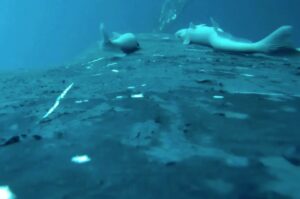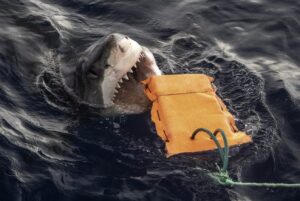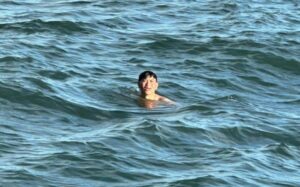In the cusp between spring and summer, a bright blue tide arrives on the shores of Oregon and California. Millions of jellyfish-like creatures called Velella Velella litter the beaches. While they may look like jellyfish, they are something else entirely.
Velella Velella, also known as By-the-wind-Sailors or Sea Rafts, belong to a class of predatory invertebrates called Hydrozoa. They are not jellyfish but are closely related both to them and to corals. They thrive in warmer and temperate waters of the Northern and Southern Hemispheres, particularly in the Pacific.

Velella Velella floating across the ocean in a blue tide. Photo: NOAA
They feed on krill, plankton, small fish, and other very minuscule sea creatures and eggs. Measuring up to 13cm, they possess one-centimetre-long tentacles. These carry a toxin that paralyzes their prey. However, this toxin only affects humans who suffer from extreme skin sensitivities.
Drifting with the winds
Despite their predatory characteristics, Velella Velella do not have the ability to move at all. They drift on the open seas, moving with the currents and winds. Additionally, they never sink or submerge themselves. Their lack of movement makes them susceptible to predators. Their mortal enemies are the sunfish and sea snails.
Its most defining feature is the distinctive triangular shape created by its sail, a thin vertical flap running diagonally across the creature’s “back”. The sail captures the wind and pushes them across the ocean.
The Velella Velella collect in droves and may eventually become stranded on land, forming a magnificent blue tide. Sometimes, they appear slightly green or golden-brown from attached algae.
Once they reach the shoreline, they start to die slowly. Their color transforms from its electric blue to completely transparent within a couple of days. They start to decay and emit a horrific smell.

The Velella Velella’s sail allows the wind to direct it. Photo: StefanMaximilian/Shutterstock
The Velella Velella is not a single organism but a whole hydroid colony of hundreds of all-male or all-female polyps. Groups of polyps in the colony serve vital functions such as asexual reproduction, ingestion, digestion, or security. When the blue sailor acquires food, the polyps transport and share it throughout the colony by an internal canal.
The reproductive polyps produce tiny jellyfish-like organisms called medusas. These take three weeks to reach sexual maturity. Their eggs and sperm transform into larva called conaria, which further develops into the colony you see today.

Showing the Velella velella’s size. Photo: Mala Iryna/Shutterstock
Mass strandings
There have been several notable mass-stranding incidents around the world. The years 1926, 1940, 1997, 2013, and 2014 saw massive blue tides because of powerful storms. While the Velella Velella like to bob around in warmer waters, they’ve recently made appearances in the British Isles. Some scientists believe that the northerly spread of their range illustrates climate change at work.






